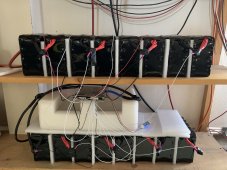Hi everyone, I’m wondering what is the reasonable range of Lifepo4 battery internal resistance.
I ask because my 48v 100ah battery system has been experiencing larger voltage drop when there is larger amps draw.
For example, a 20amps draw cause battery voltage drops around 1 volt from 52v to 51v. I measured with volt meter around 0.8v drop is between those 16 cell packs, only 0.2v by bms. I’m using 16 3.2v 32700 cells package from Batteryhookup. So my battery system has 50 mohms internal resistance.
If I try full load of 100amps, the voltage drop will be 5 volt, that is tooooo much. Even 1 volt drop has been causing Growatt to switch power mode unnecessarily since most settings are based on voltage. On the other side, I wish Growatt has built in shunt and use battery capacity instead of voltage to decide when to switch with grid.
Does anyone have experience dealing with this type of issues? Any suggestions?
I ask because my 48v 100ah battery system has been experiencing larger voltage drop when there is larger amps draw.
For example, a 20amps draw cause battery voltage drops around 1 volt from 52v to 51v. I measured with volt meter around 0.8v drop is between those 16 cell packs, only 0.2v by bms. I’m using 16 3.2v 32700 cells package from Batteryhookup. So my battery system has 50 mohms internal resistance.
If I try full load of 100amps, the voltage drop will be 5 volt, that is tooooo much. Even 1 volt drop has been causing Growatt to switch power mode unnecessarily since most settings are based on voltage. On the other side, I wish Growatt has built in shunt and use battery capacity instead of voltage to decide when to switch with grid.
Does anyone have experience dealing with this type of issues? Any suggestions?
Last edited:




